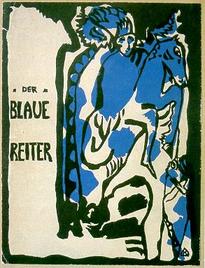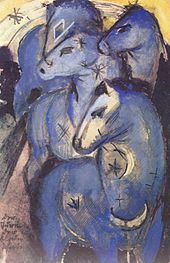Der Blaue Reiter

Der Blaue Reiter (The Blue Rider) was a group of artists from the Neue Künstlervereinigung München in Munich, Germany. Der Blaue Reiter was a German movement lasting from 1911 to 1914, fundamental to Expressionism, along with Die Brücke which was founded the previous decade in 1905.
History
Wassily Kandinsky, Franz Marc, August Macke, Alexej von Jawlensky, Marianne von Werefkin, Gabriele Münter, Lyonel Feininger, Albert Bloch and others founded the group in response to the rejection of Kandinsky's painting Last Judgement from an exhibition. Der Blaue Reiter lacked a central artistic manifesto, but was centred around Kandinsky and Marc. Paul Klee was also involved.

The name of the movement comes from a painting by Kandinsky created in 1903 (see illustration). It is also claimed that the name could have derived from Marc's enthusiasm for horses and Kandinsky's love of the colour blue. For Kandinsky, blue is the colour of spirituality: the darker the blue, the more it awakens human desire for the eternal (see his 1911 book On the Spiritual in Art).
Within the group, artistic approaches and aims varied from artist to artist; however, the artists shared a common desire to express spiritual truths through their art. They believed in the promotion of modern art; the connection between visual art and music; the spiritual and symbolic associations of colour; and a spontaneous, intuitive approach to painting. Members were interested in European medieval art and primitivism, as well as the contemporary, non-figurative art scene in France. As a result of their encounters with cubist, fauvist and Rayonist ideas, they moved towards abstraction. "As a founding father of abstract art at the turn of the 20th Century, Kandinsky used the intensity and abstraction of musical compositions to inspire his paintings." [1] "Regarding his oil paintings Kandinsky said 'Color is the keyboard, the eyes are the harmonies, the soul is the piano with many strings. The artist is the hand that plays, touching one key or another, to cause vibrations in the soul.' "[2]
Der Blaue Reiter organized exhibitions in 1911 and 1912 that toured Germany. They also published an almanac featuring contemporary, primitive and folk art, along with children's paintings. In 1913 they exhibited in the first German Herbstsalon.
The group was disrupted by the outbreak of the First World War in 1914. Franz Marc and August Macke were killed in combat. Wassily Kandinsky, Marianne von Werefkin and Alexej von Jawlensky were forced to move back to Russia because of their Russian citizenship. There were also differences in opinion within the group. As a result, Der Blaue Reiter was short-lived, lasting for only three years from 1911 to 1914.
In 1923 Kandinsky, Feininger, Klee and Alexej von Jawlensky formed Die Blaue Vier (the Blue Four) group, and exhibited and lectured together in the United States in 1924.
An extensive collection of paintings by Der Blaue Reiter is exhibited in the Städtische Galerie in the Lenbachhaus in Munich.
Almanac
Conceived in June 1911, Almanack der Blaue Reiter (The Blue Rider Almanac) was published in early 1912, by Piper, Munich, in an edition of 1100 copies; on 11 May, Franz Marc received a first print. The volume was edited by Kandinsky and Marc; its costs were underwritten by the industrialist and art collector Bernhard Koehler, a relative of Macke. It contained reproductions of more than 140 artworks, and 14 major articles. A second volume was planned, but the start of World War I prevented it. Instead, a second edition of the original was printed in 1914, again by Piper.[3]
The contents of the Almanac included:
- Marc's essay "Spiritual Treasures," illustrated with children's drawings, German woodcuts, Chinese paintings, and Pablo Picasso's Woman with Mandolin at the Piano[4]
- an article by French critic Roger Allard on Cubism
- Arnold Schoenberg's article "The Relationship to the Text", and a facsimile of his song "Herzgewächse"
- facsimiles of song settings by Alban Berg and Anton Webern
- Thomas de Hartmann's essay "Anarchy in Music"
- an article about Alexander Scriabin's Prometheus: The Poem of Fire
- an article by Erwin von Busse on Robert Delaunay, illustrated with a print of his The Window on the City
- Macke's essay "Masks"
- Kandinsky's essay "On the Question of Form"
- Kandinsky's "On Stage Composition"
- Kandinsky's The Yellow Sound.
The art reproduced in the Almanac marked a dramatic turn away from a Eurocentric and conventional orientation. The selection was dominated by primitive, folk, and children's art, with pieces from the South Pacific and Africa, Japanese drawings, medieval German woodcuts and sculpture, Egyptian puppets, Russian folk art, and Bavarian religious art painted on glass. The five works by Van Gogh, Cezanne, and Gauguin were outnumbered by seven from Henri Rousseau and thirteen from child artists.[5]
Exhibitions
- First exhibition
December 18, 1911, the "First exhibition of the editorial board of Der Blaue Reiter" (Erste Ausstellung der Redaktion Der Blaue Reiter) opened at the Heinrich Thannhauser's Moderne Galerie in Munich, running through the first days of 1912. 43 works by 14 artists were shown: paintings by Henri Rousseau, Albert Bloch, David Burliuk, Wladimir Burliuk, Heinrich Campendonk, Robert Delaunay, Elisabeth Epstein, Eugen von Kahler, Wassily Kandinsky, August Macke, Franz Marc, Gabriele Münter, Jean Bloé Niestlé and Arnold Schönberg, and an illustrated catalogue edited.[6]
From January 1912 through July 1914, the exhibition toured Europe with venues in Cologne, Berlin, Bremen, Hagen, Frankfurt, Hamburg, Budapest, Oslo, Helsinki, Trondheim and Göteborg.[7]
- Second exhibition
February 12 through April 2, 1912, the "Second exhibition of the editorial board of Der Blaue Reiter" showed works in "Black & White" (Zweite Ausstellung der Redaktion Der Blaue Reiter, Schwarz-Weiß) at the "New Art" Gallery of Hans Goltz (Neue Kunst Hans Goltz) in Munich.[8]
- Other shows
The artists of Der Blaue Reiter also participated in:
- 1912 Cologne, Sonderbund westdeutscher Kunstfreunde und Künstler
- 1913 Berlin, Erster Deutscher Herbstsalon organised by Herwarth Walden and his gallery Der Sturm
Members

- Wassily Kandinsky
- Franz Marc
- August Macke
- Paul Klee
- Gabriele Münter
- Alexej von Jawlensky
- Heinrich Campendonk
- Albert Bloch
- Natalia Goncharova
- Marianne von Werefkin
- Lyonel Feininger
- Arnold Schoenberg
- David Burliuk
See also
Notes
- ^ http://www.1artclub.com/last-judgement/
- ^ http://www.1artclub.com/last-judgement/
- ^ Katharina Erling: Der Almanach Der Blaue Reiter, in: Hopfengart (2000), pp. 188-239
- ^ Peter Nicholls, Modernisms: A literary Giude, Berkeley, CA, University of California Press, 1995; p. 141.
- ^ George Heard Hamilton, Painting and Sculpture in Europe, 1880–1940, New Haven, CT, Yale University Press, 1993; pp. 215-16.
- ^ Catalogue, reproduced in Hoberg & Friedel (1999), pp. 364-365.
- ^ Ortrud Westheider et alt.: Die Tournee der ersten Ausstellung des Blauen Reiters, in: Christine Hopfengart (2000), pp. 49-82
- ^ Catalogue?
References
- John E. Bowlt, Rose-Carol Washton Long. The Life of Vasilii Kandinsky in Russian art : a study of "On the spiritual in art" by Wassily Kandinsky. Pub l. Newtonville, Mass. USA. 1980. ISBN 0-89250-131-6 ISBN 0-89250-132-4
- Wassily Kandinsky, M. T. Sadler (Translator) Concerning the Spiritual in Art. Dover Publ. (Paperback). 80 pp. ISBN 0-486-23411-8. or: Lightning Source Inc. Publ. (Paperback). ISBN 1-4191-1377-1
- Shearer West (1996). The Bullfinch Guide to Art. UK: Bloomsbury Publishing. ISBN 0-8212-2137-X.
- Hoberg, Annegret, & Friedel, Helmut (ed.): Der Blaue Reiter und das Neue Bild, 1909-1912, Prestel, München, London & New York 1999 ISBN 3-7913-2065-3
- Hopfengart, Christine: Der Blaue Reiter, DuMont, Cologne 2000 ISBN 3-7701-5310-3
